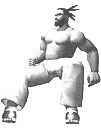PANKRATION: "First Ultimate Fighting Martial Arts in the World"
Pankration is the first Pre-Christian form of ultimate martial arts fighting in the world. Pankration, sometimes spelled pancration, or pancratium or even pankatium, was a combination of earlier forms of boxing, wrestling, and kicking, practiced by the Greeks. Some historians trace its origin to the Indian vajramushti system. It should be noted, however, that pankration and the Pyrrhic dance, a Greek armed and unarmed war-dance similar to modern karate kata, both show Indian statues depicting temple guardians in poses similar to those used latter day fighting arts.
In 648 B.C. pankration was introduced to the Geek Olympic Games. Subdivision, boy’s pankration, was added in the 2nd century B.C., which attests to the popularity of the sport. The object was to force an opponent to acknowledge defeat, and to this end almost any means might be applied. Though officials with a switch or stout rod enforced rules, a whipping must have been more desirable than being killed, for the rules sere often broken, Serious injuries and fatal accidents did occur, but they were rare.
Facing one another, much as in the position taken by wrestlers, pankratiasts, as they were called, tried to bring one another violently to the ground by grappling, hitting, kicking, leg sweeping, choking, or joint-locking. There was much preliminary sparring. Hands were bare and generally held open, although the clenched first was used for hitting; feet were also bare. As in Greek boxing, there were no rules against hitting a man when down. More often than not, the contest was decided on the ground, even though, when both fighters were down. Biting and gouging were prohibited. Kicking was an essential part of pankration and the stomach area was a common target. Because of this comparatively rare tactic, historians speculate that pankration may have been one of the first, if not the first, total martial art known to mankind.
In the palaestra, the Greek wrestling school, pankration was given a separate training room, known as the Korykeion, equipped with punching and kicking balls, called korykos, suspended from the ceiling beams. The Greek boxer and the pankratiast used the punch ball much as the modern boxer does. Another large ball, used for kicking practice, hung about 2 feet from the floor. Pankration was taught progressively; when a student had thoroughly learned the movements and their combinations he would be permitted to engage in "loose play." As it is called in fencing.
Some historians and martial art scholars believe that Alexander the great made friends with Dioxippus, the champion pankratiast who won the Olympic crown by default in 336 B.C. because no one dared compete against him. Later, as Alexander marched in conquest across the world, his armies carried with them elaborate tents, more like collapsible amphitheaters, in which they could practice and play athletic games, foremost among them pankration. Some martial arts scholars believe Alexander’s armies, in carrying pankration across the Himalayas in 326 B.C., laid the groundwork for kung fu in China.
Greek PANKRATION, ancient Greek sports event that combined boxing and wrestling, introduced at the Xxxiii Olympiad (648 BC). Simple fisticuffs had been introduced in 688 BC. Particularly popular among Spartans, contests were savage, with hitting, kicking, twisting of limbs, strangling, and struggling on the ground allowed. The only recognized fouls were biting and gouging. A contest ended when one of the fighters acknowledged defeat. |





